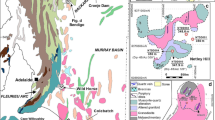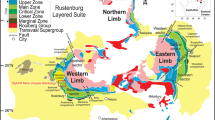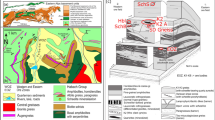Abstract
The effect of a saline environment on illitization in volcanoclastic rocks is examined in deep boreholes in the East Slovak Basin. Based on X-ray diffraction analysis, it is concluded that illite-smectite (I–S) expandability is always less in the salt-bearing bentonites (SBB) than in the salt-free bentonites (SFB) for a given depth interval. These two lithologies can be distinguished easily by water-leachate chemistry. Within the depth interval 2100–2500 m, the expandability in SBB varies within the range 25–10% expandable with R1 and R3 ordering in SBB and 68–35% expandable with R0 ordering in SFB. In two shallow SBB samples the expandability is close to that of SFB, suggesting that salinity alone does not enhance the illitization; but salinity may enhance it when combined with higher burial temperature. Vitrinite reflectance and Tmax of RockEval pyrolysis measured in adjacent shales confirm that the increased illitization in SBB is not due to heating and/or erosion. The model of burial and thermal history calibrated by organic maturity suggests that the same thermal history produces two different expandabilities in the two lithologies (SBB and SFB). Particle thickness measurements and K-Ar data were used to deduce the crystal growth mechanism of illitization in SBB. Whereas surface-controlled growth is typical for SFB, simultaneous nucleation and growth played a more important role in the case of SBB. The effect of a salty environment on the illitization is not yet fully understood and may have severe consequences for the utilization of bentonites as engineering barriers in radioactive waste disposal sites if salt formations used as host rocks are taken into account.
Similar content being viewed by others
References
Baráth, I., Kováč, M., Soták, J. and Lankreijer, A. (1997) Tertiary collision, metamorphism and basin forming processes in the Eastern Slovakia (central Western Carpathians). Pp. 65–78 in: Geological Evolution of the Western Carpathians (P. Grecula, D. Hovorka and M. Putiš, editors). Mineralia Slovaca — Monograph, Bratislava.
Bauer, A. and Velde, B. (1999) Smectite transformation in high molar KOH solutions. Clay Minerals, 34, 259–273.
Bonhomme, M., Thuizat, R., Pinault, Y., Clauer, N., Wendling, R. and Winkler, R. (1975) Methode de datation potassiumargon. Appareillage et technique. Note technique de l’Institut de Géologie, Université Strasbourg, 3, 53 pp.
Clauer, N., Srodoñ, J., Franců, J. and Šucha, V. (1997) K-Ar dating of illite fundamental particles separated from illitesmectite. Clay Minerals, 32, 181–196.
Cox, A. and Dalrymple, G.B. (1967) Statistical analysis of geomagnetic reversal data and the precision of potassiumargon dating. Journal of Geophysical Research, 72, 2603–2614.
Deconinck, J.F., Strasser, A. and Debrabant, P. (1988) Formation of illitic minerals at surface temperatures in Purbeckian sediments (Lower Berriasian, Swiss and French Jura). Clay Minerals, 23, 91–103.
Drits, V.A., Eberl, D.D. and Środoń, J. (1998) XRD measurement of mean thickness, thickness distribution and strain for illite and illite/smectite crystallites by the Bertaut-Warren-Averbach technique. Clays and Clay Minerals, 46, 461–475.
Dudek, T. and Środoń, J. (1996) Identification of illite/smectite by X-ray powder diffraction taking into account the lognormal distribution of crystal thickness. Geologica Carpathica — Clays, 5, 21–32.
Dudek, T., Środoń, J., Eberl, D.D., Elsass, F. and Uhlík, P. (2002) Thickness distribution of illite crystals in shales. Part I: X-ray diffraction vs. high-resolution transmission electron microscopy measurements. Clays and Clay Minerals, 50, 562–577.
Eberl, D.D. and Hower, J. (1976) Kinetics of illite formation. Geological Society of America Bulletin, 87, 1326–1330.
Eberl, D.D., Środoń, J. and Northrop, H.R. (1986) Potassium fixation in smectite by wetting and drying. Pp. 296–326 in: Geochemical Processes at Mineral Surfaces (J.A. Davis and K.F. Hayes, editors). ACS Symposium Series, 323, American Chemical Society.
Eberl, D.D., Velde, B. and McCormick, T. (1993) Synthesis of illite-smectite from smectite at earth surface temperatures and high pH. Clay Minerals, 28, 49–60.
Eberl, D.D., Drits, V., Środoń, J. and Nüesch, R. (1996) MudMaster: a program for calculating crystallite size distribution and strain from the shapes of X-ray diffraction peaks. US Geological Survey, Open-File report 96-171.
Eberl, D.D., Nüesch, R., Šucha, V. and Tsipursky, S. (1998a) Measurement of fundamental illite particle thickness by X-ray diffraction using PVP-10 intercalation. Clays and Clay Minerals, 46, 89–97.
Eberl, D.D., Drits, V.A. and Środoń, J. (1998b) Deducing growth mechanisms for minerals from the shapes of crystal size distributions. American Journal of Science, 298, 499–533.
Eberl, D.D., Drits, V.A. and Środoń, J. (2001) User’s guide to GALOPER — a program for simulating the shapes of crystal size distributions—and associated programs. US Geological Survey Open-File report OF00-505, 44 pp.
Elsass, F., Beaumont, A., Pernes, M., Jaunet, A.-M. and Tessier, D. (1998) Changes in layer organization of Na- and Ca-exchanged smectite materials during solvent exchanges for embedment in resin. The Canadian Mineralogist, 36, 1475–1483.
Franců, J., Rudinec, R. and Šimánek, V. (1989) Hydrocarbon generation zone in the East Slovakian Neogene basin: model and geochemical evidence. Geologický zborník. —Geologica Carpathica, 40, 355–384.
Franců, J., Müller, P., Šucha, V. and Zatkalíková, V. (1990) Organic matter and clay minerals as indicators of thermal history in the Transcarpathian depression (East Slovakian Neogene basin) and the Vienna basin. Geologický zborník. — Geologica Carpathica, 41, 535–546.
Galamay, A.R. and Karoli, S. (1997) Geochemistry of the Badenian salts from the East Slovak basin (Slovakia). Slovak Geological Magazine, 3, 187–192.
Hay, R.L., Guldman, S.G., Matthews, J.C., Lander, R.H., Duffin, M.E. and Kyser, T.K. (1991) Clay mineral diagenesis in core KM-3 of Searles Lake, California. Clays and Clay Minerals, 39, 84–96.
Heller-Kallai, L. and Eberl, D.D. (1997) Potassium fixation by smectites in wetting-drying cycles with different anions. Proceedings of the International Clay Conference, Ottawa, pp. 561-567
Honty, M., Šucha, V. and Magyar, J. (2002) Rock-facies dependent use of illite-smectite paleothermometry. Mineralia Slovaca, 34, 29–34.
Honty, M., Šucha, V. and Puškelová, L. (2003) Potassium fixation in smectites by wetting and drying with NaCl solutions. Geologica Carpathica, 54, 261–264.
Hower, J., Eslinger, E.V., Hower, M.E. and Perry, E.A. (1976) Mechanism of burial metamorphism of argillaceous sediment: 1. Mineralogical and chemical evidence. Geological Society of America Bulletin, 87, 725–737.
Huang, W.-L., Longo, J.M. and Pevear, D.R. (1993) An experimentally derived kinetic model for smectite-to-illite conversion and its use as a geothermometer. Clays and Clay Minerals, 41, 162–177.
Jackson, M.L. (1975) Soil Chemical Analysis — Advanced Course. Published by the author, Madison, Wisconsin, 386 pp.
Karoli, S. (1993) Evaporite facies in the Neogene East Slovakia Basin. Abstracts of the 8th Meeting of the Association of European Geological Societies, Budapest.
Karoli, S., Janočko, J., Kotulák, P. and Verdon, P. (1997) Sedimentology of Karpatian evaporites in the East-Slovakian Neogene basin (Slovakia). Slovak Geological Magazine, 3, 201–211.
Kile, D.E., Eberl, D.D., Hoch, A.R. and Reddy, M.M. (2000) An assessment of calcite crystal growth mechanisms based on crystal size distributions. Geochimica et Cosmochimica Acta, 64, 2937–2950.
Kováč, M., Kováč, P., Marko, F., Karoli, S. and Janočko, J. (1995) The East Slovakian Basin — a complex back arc basin. Tectonophysics, 252, 453–466.
Král’, M., Lizon, I. and Jančí, J. (1985) Geothermal Research in Slovakia. Geofond, Bratislava (in Slovak).
Lexa, J., Konečný, V., Kaličiak, M. and Hojstričová, V. (1993) Distribution of the Carpathian Pannonian region volcanites in space and time. Pp. 57–71 in: Geodynamick model a hlbinná stavba Západnch Karpát (M. Rakðs and J. Vozár, editors). Konferencie—Sympóziá-Semináre, GÚDŠ Bratislava (in Slovak).
Mello, U.T., Karner, G.D. and Anderson, R.N. (1995) Role of salt in restraining the maturation of subsalt source rocks. Marine and Petroleum Geology, 12, 697–716.
Michalíček, M. (1965) Příspěvek k hydrogeochemii a hydrogeologii hlubinnch vod Trebišovské nížiny. Geologìcké práce, Zprâvy, 35, 167–185 (in Czech).
Michalíček, M. (1970) K původu chloridosodných solanek v miocénu trebišovské nížiny. Sborník geologických věd, řada HIG, 7, 107–159 (in Czech).
Mosser-Ruck, R., Cathelineau, M., Baronnet, A. and Trouiller, A. (1999) Hydrothermal reactivity of K-smectite at 300°C and 100 bar: dissolution-crystallization process and non-expandable dehydrated smectite formation. Clay Minerals, 34, 275–290.
Nadeau, P.H. and Reynolds, R.C. (1981) Burial and contact metamorphism in the Mancos shale. Clays and Clay Minerals, 29, 249–259.
Nier, A.O. (1950) A redetermination of the relative abundances of the isotopes of carbon, nitrogen, oxygen, argon and potassium. Physical Review, 77, 789–793.
Odin, G.S. and Bonhomme, M.G. (1982) Argon behaviour in clays and glauconies during preheating experiments. Pp. 333–343 in: Numerical Dating in Stratigraphy (G.S. Odin, editor). John Wiley, New York.
Poelchau, H.S., Baker, D.R., Hantschel, T., Horsfield, B. and Wygrala, B. (1997) Basin simulation and the design of the conceptual basin model. Pp. 5–70 in: Petroleum and Basin Evolution (D.H. Welte, B. Horsfield and D.R. Baker, editors). Springer, Berlin, Heidelberg, New York.
Pollastro, R.M. (1993) Considerations and applications of the illite/smectite geothermometer in hydrocarbon-bearing rocks of miocene to mississipian age. Clays and Clay Minerals, 41, 119–133.
Rudinec, R. (1989) New view on the paleogeographic development of the Transcarpathian Depression during the Neogene. Mineralia Slovaca, 21, 27–42.
Rudinec, R. (1990) Vertical distribution of Neogene sediments in the transcarpathian depression. Mineralia Slovaca, 22, 5, 393–397.
Singer, A. and Stoffers, P. (1980) Clay mineral diagenesis in two east African lake sediments. Clay Minerals, 15, 291–307.
Środoń, J. (1981) X-ray identification of randomly interstratified illite-smectite in mixtures with discrete illite. Clay Minerals, 16, 297–304.
Środoń, J. (1984) Mixed-layer illite-smectite in low-temperature diagenesis: data from the Miocene of the Carpathian foredeep. Clay Minerals, 19, 205–215.
Środoń, J. (1995) Reconstruction of maximum paleotemperatures at present erosional surface of the Upper Silesia Basin, based on the composition of illite/smectite in shales. Studia Geologica Polonica, 108, 9–20.
Środoń, J. and Eberl, D.D. (1984) Illite. Pp. 495–544 in: Micas (S.W. Bailey editor). Reviews in Mineralogy, 13, Mineralogical Society of America, Washington, D.C.
Środoń, J., Eberl, D.D. and Drits, V.A. (2000) Evolution of fundamental-particle size during illitization of smectite and implications for reaction mechanism. Clays and Clay Minerals, 48, 446–458.
Środoń, J., Clauer, N. and Eberl, D.D. (2002) Interpretation of K-Ar dates of illitic clays from sedimentary rocks aided by modeling. American Mineralogist, 87, 1528–1535.
Steiger, R.H. and Jäger, E. (1977) Subcommission on geochronology: convention on the use of decay constants in geo- and cosmochronology. Earth and Planetary Science Letters, 36, 359–362.
Sweeney, J.J. and Burnham, A.K. (1990) Evaluation of a simple model of vitrinite reflectance based on chemical kinetics. American Association of Petroleum Geologists Bulletin, 74, 1559–1570.
Šucha, V., Kraus, I., Gerthofferová, H., Peteš, J. and Sereková, M. (1993) Smectite to illite conversion in bentonites and shales of the East Slovak Basin. Clay Minerals, 28, 243–253.
Tessier, D. (1984) Étude experimental de l’organisation des materiaux argileux. Dr. Science thesis, Université Paris VII, INRA, 361 pp.
Turner, C.E. and Fishman, N.S. (1991) Jurassic lake T’oo’dichi’: a large alkaline, saline lake, Morrison formation, eastern Colorado Plateau. Geological Society of America Bulletin, 103, 538–558.
Uhlík, P., Šucha, V., Elsass, F. and Čaplovičová, M. (2000) High-resolution transmission electron microscopy of mixed-layer clays dispersed in PVP-10: anew technique to distinguish detrital and authigenic illitic material. Clay Minerals, 35, 781–789.
Vass, D. and Čverčko, J. (1985) Neogene Lithostratigraphic Units in the East-Slovakian Lowland. Geologické Práce, Správy, 82, 111–126 (in Slovak).
Vass, D., Kováč, M., Konečný, V. and Lexa, J. (1988) Molasse basins and volcanic activity in West Carpathian Neogene — its evolution and geodynamic character. Geologica Carpathica, 39, 539–562.
Whitney, G. (1990) Role of water in the smectite-to-illite reaction. Clays and Clay Minerals, 38, 343–350.
Whitney, G. and Northrop, H.R. (1988) Experimental investigation of the smectite to illite reaction: dual reaction mechanisms and oxygen-isotope systematics. American Mineralogist, 73, 77–90.
Author information
Authors and Affiliations
Corresponding author
Rights and permissions
About this article
Cite this article
Honty, M., Uhlík, P., Šucha, V. et al. Smectite-to-illite alteration in salt-bearing bentonites (The East Slovak Basin). Clays Clay Miner. 52, 533–551 (2004). https://doi.org/10.1346/CCMN.2004.0520502
Received:
Revised:
Published:
Issue Date:
DOI: https://doi.org/10.1346/CCMN.2004.0520502




